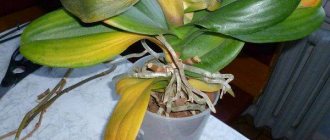Symptoms and causes of the disease
Accurate knowledge of the causes of flower disease will help you understand how to save the orchid and provide it with proper care.
Orchid diseases:
- Problems with flowering. There are three main ones:
- doesn't bloom
- buds may wither or rot,
- Dark spots appear on the flowers.
A healthy orchid in the right conditions
- Various rots:
- Brown bacterial. In this case, the leaves begin to rot.
- Rotten roots. In most cases a transplant will be required.
- The leaves may rot and become covered with a gray or black coating - this indicates the presence of fungi.
- Fusarium rot - leaves begin to turn yellow.
- Leaf diseases:
- Anthracnose. The leaves are infected by a fungus and become covered with small black spots. This happens due to stagnation of water in the leaf axils.
- Bacterial spotting. First, the leaves turn yellow, then they can rot, then they soften, crack, and can dry out and fall off.
- Leaf deformation, lost turgor.
- Leaf burn. Often occurs in the summer. If you do not put the orchid in the shade in time, the leaves will die very quickly, forming holes at the burn sites.
- Powdery mildew. The plant becomes covered with a white coating and will soon die if no action is taken.
- Viral diseases. They do not manifest themselves for a long time, cannot be treated, and the flower will have to be destroyed.
Important! As soon as a virus is detected in an orchid, it should be immediately removed from other plants and destroyed. If watering is common in one container, then other flowers are probably infected. In this case, they must be treated with antibiotics.
The causes of diseases can be:
- A virus or fungus can be introduced using tools.
- Overheat.
- Over or under watering.
- Incorrect amount of feeding.
- Parasites, insects in the soil.
- The substrate has not changed for a long time.
- Bad light.
Possible causes of rotting
Root rotting occurs due to too frequent watering of the soil, which occurs during the hibernation period of phalaenopsis. This usually happens in autumn or winter, when the plant does not need as much moisture and watering should be reduced. To revive an orchid, you need to know the reasons that caused problems with it, and then boldly eliminate them without harm to the flower.
Possible reasons if the orchid's roots begin to rot:
- The soil was not replaced and it became crumpled. If there is stagnation of moisture, there is a possibility that the roots have disappeared.
- In poor lighting, some of the water is not absorbed, remaining on the soil surface. High humidity negatively affects the roots, but lack of moisture causes them to dry out.
- The orchid's root system is delicate and is easily damaged due to improper feeding. For example, a chemical burn will occur if the flower is fertilized too often.
- When replanting an orchid, there is a chance of damaging the roots and allowing them to become infected, leading to the process of rotting.
- Phalaenopsis may be attacked by pests that feed on its roots.
Note!
The root system gets sick quite slowly, and even the blooming appearance of a flower is not an indicator that everything is fine with it. If an orchid dies, it must be treated to prevent complete death of the plant. Rotting is detected if:
- orchid growth slows down or stops;
- the roots have dried out and the leaves turn yellow;
- flowers fall;
- the plant wobbles in the ground.
A rotten spot on the root is also a visible factor in its infection. Even when cutting a light root, you can see the black core in it. It is also necessary to monitor the release of mucus when pressing on the root. Because of these problems, it is worth knowing how to resuscitate an orchid without roots.
How to revive rotten roots
Aerial orchid roots: transplantation and other options
How to revive an orchid if all the roots have rotted is not an easy question and requires special work.
You should understand! Rotten roots can no longer be saved, so they will need to be regrown.
Steps to solve the problem:
- Remove the flower from the pot
- Clear the root system of soil and rinse thoroughly.
- Trim off all rotten rhizomes using disinfected tools (knife or scissors). Only healthy tissue remains.
- Treat the sections with crushed charcoal and fungicide.
- If mold is detected, immerse the plant in a solution of potassium permanganate for a few minutes.
If the roots still remain after treatment, then it is necessary to transplant the plant into a substrate, but into a small pot. Be sure to provide the orchid with good lighting and a constant temperature of 22-25 degrees.
The orchid's roots are rotting
Freezing and sunburn
A tropical delicate orchid may well become hypothermic - in our climate this is not surprising. If only the leaves and peduncles were frozen, then, without any doubt, the plant will survive and recover, although not quickly.
If the roots are damaged, resuscitation will be more drawn out, but, however, in most cases it will also be successful. However, if the growing point is caught in frost and the latter becomes watery and translucent, unfortunately, the orchid cannot be restored.
In case of sunburn, the affected leaves and flowers should be torn off, since it is no longer possible to restore their beauty. Then be sure to move the orchid to a shady area.
Orchid without roots
How to revive an orchid at home when all its roots have rotted:
- Use regular drying and dosed watering;
- Using mini-greenhouses.
How to prune an orchid after flowering: options at home
After all rotten roots are removed, the orchid is treated with any root growth stimulator.
Additional Information. “Kornevin” for orchids is a root growth stimulator and is often used to solve the problem. This is a hormonal biological preparation that stimulates root formation.
Pour water into a regular glass, adding sugar or honey (1 teaspoon per 1 liter). Then the rosette of the plant is placed in the glass so that the leaves do not come into contact with the water, and the lower part is completely immersed in it. After 8 hours, the water must be drained and the flower dried. Afterwards, be sure to treat the rosette with a root growth stimulator.
A mini-greenhouse is the most effective way to resuscitate a plant in the absence of a root. Take a small container where the flower will be rooted, filling the bottom with expanded clay and the top with sphagnum. Place the rosette on the prepared substrate and place the container in the greenhouse.
Phalaenopsis leaf without roots
Be sure to comply with the following conditions:
- Temperature – 22-28 degrees,
- Lighting – up to 14 hours a day,
- Humidity – at least 70%.
The greenhouse must be ventilated and the soil moistened. After a couple of weeks, roots will begin to grow. After they reach 4-5 cm, you can plant the plant in the substrate.
Growing
Growing the most amazing plant on the entire planet, an orchid, at home is an interesting and painstaking task. Considering that this flower naturally lives in a tropical climate with high humidity, good lighting and warm air temperatures, it is necessary to bring home conditions closer to these requirements.
These unique plants grow well at home in places with good natural or artificial light. When placing a flower on a windowsill, you must ensure that it is not exposed to direct sunlight, which can cause burns. It is better to choose windows facing east or west. In summer, it is advisable to protect the flower from the bright sun with a special plant net. If the flower is located deep in the room, then it needs artificial lighting for 12-14 hours. Usually a fluorescent lamp or phytolamp is used.
Temperature is important for proper plant development. It is advisable to maintain the temperature within +18 ... + 28 degrees Celsius all year round. In winter, it is necessary to monitor changes in night temperatures for plants located on window sills. The norm is within 4 -5 degrees Celsius; a larger gap between temperatures can contribute to flower disease. In summer during drought, the plant needs systematic irrigation
It is important to pay attention to the watering regime. Usually water twice a week, as the soil dries out. When there is excess moisture, putrefactive processes occur, contributing to plant diseases and attracting pests.
It is periodically required to introduce fertilizing, taking into account the phase of plant development and seasonality. During the winter and summer periods, fertilizers are applied no more than once a month, and in the spring and autumn periods - once every two weeks, if the plant does not flower.
With excess moisture, putrefactive processes occur, contributing to plant diseases and attracting pests. It is periodically required to introduce fertilizing, taking into account the phase of plant development and seasonality. During the winter and summer periods, fertilizers are applied no more than once a month, and in the spring and autumn periods - once every two weeks, if the plant does not flower.
It is recommended to introduce fertilizing when the flower is dormant. It is better to choose specially developed fertilizers for this type of indoor flowers. In the active growing season, phosphorus and nitrogen-containing substances are used, which help improve the process of photosynthesis, protein and carbohydrate metabolism. At the beginning of flowering, when the first peduncle appears, fertilizing containing phosphorus and potassium is applied. This has a significant impact on the formation of peduncles and buds. You can fertilize using the root and foliar (leaf) methods.
Withered leaves
Is it possible to keep an orchid at home: options why it’s good or bad
When you have managed to grow the roots of the orchid, you can plant the flower in a pot with soil. However, there are situations when the leaves of a plant begin to wither and they stop holding their shape.
Loss of leaf turgor
How to save an orchid without roots and with limp leaves:
- Start growing roots.
- If there are rotten parts of the leaf, they should be cut off and the sections treated with charcoal, brilliant green or cinnamon. Then dry for about eight hours.
- Create conditions for regeneration and revitalization of the flower.
- Droopy leaves are restored with the help of compresses: the bandage is soaked in succinic acid.
Additional Information. Succinic acid is often used as a fertilizer for orchids. This is a salvation in many cases, especially if the plant is withering. Succinic acid is an absolutely safe biostimulant that will help “revive” the flower and restore it after suffering stress.
Often, old leaves do not regain their shape, but turn yellow and fall off. Instead, new strong and strong leaves grow.
Improper watering and its consequences
When an orchid is watered too diligently, this can lead to rotting of the plant's roots, wilting of the leaves, and other unpleasant problems, including the development of fungal pathology.
To avoid such problems, you should moisten the soil only when it has noticeably dried out. If you water the orchid without waiting for the soil to dry, this will inevitably lead to plant disease. And it will be difficult to rehabilitate the flower.
The time that passes between waterings is difficult to determine exactly. This depends on many factors: external conditions, temperature, air humidity levels, lighting, soil composition, even the type of flower.
The size of the pot also matters: in a large container the soil will dry out more slowly. Therefore, it is recommended to initially plant a tropical flower in a tall and rather narrow container.
It is also important to prevent the roots from drying out, since this fact will undoubtedly negatively affect the health of the orchid. And it may even lead to its complete death.
Resuscitation at home
Reanimating an orchid at home requires a lot of patience and painstaking care for the plant. It is imperative to prepare all the conditions for reviving the flower and further maintenance.
Additional Information. When there is too much light, the plant's leaves turn bright green. Diminish the amount of light until the leaves turn pale green again.
Conditions of detention
Phalaenopsis requires the following maintenance conditions:
- Lighting – diffused, without bright sunlight.
- Temperature – avoid drafts and air conditioning.
- Humidity – 60-70%.
- Watering is regular. You can’t overfill a flower or place a pot with a plant in a basin of water for 25-30 minutes 1-2 times a week.
- The right soil. You can buy soil at the store and add pieces of expanded clay, oak bark and charcoal to it.
- Feeding. Fertilizers should contain nitrogen, phosphorus and iron.
Note! The most difficult period for phalaenopsis is autumn-winter. The air temperature drops significantly outside, causing the heating to turn on at home. In this case, the temperature in the rooms rises, the air becomes less humid. Also, the color day is shortened, so the orchid receives less sunlight.
Conditions for recovery
In order for the orchid to recover without problems, the following conditions must be observed:
- Watering must be very careful.
- You should not fertilize the flower for about a month after “revival” to avoid a negative reaction. Afterwards, introduce fertilizing gradually.
- Control the presence of pests.
- Use only high-quality substrate.
- Maintain comfortable living conditions for the orchid.
Preventive measures to prevent orchid leaf loss
Neither the leaves nor the root system will rot if the appropriate care rules are followed. The first and most important thing comes down to the fact that the orchid calmly tolerates dry soil, but rots when water stagnates at the bottom of the container.
It is quite difficult for novice gardeners to determine when the soil needs additional moisture. A plastic pot will be an excellent helper in watering. Its transparent walls will be an excellent guide for monitoring the condition of the rhizome, so as not to dry out or flood the soil.
Orchids get sick not only due to overheating, but also due to lack of lighting. In both cases, the plant requires a change of residence. Otherwise, resuscitation of the flower will not be successful. You cannot place an orchid on a window without curtains or blinds, or next to heating devices that are not covered with a shield. This will cause overheating.
The best choice would be to place the orchid on a special stand. It should be located near a window oriented to the southeast or southwest. The main thing is that direct rays do not fall on the foliage of the flower. Otherwise, the plates will get burned, which will cause them to fall off.
Care instructions
Some time after the plant has been restored, buds will begin to appear. A wilted peduncle should be removed after the petals have fallen. If you cut the stems too early, new ones will be able to form only after six months.
During the dormant period, the flower is placed in a warm, not very lit place. After pruning, the orchid usually rests for two months.
Orchid in a transparent pot
Required rest care:
- Don't deprive the light.
- Temperatures during the day – up to 24 degrees, at night – up to 16.
- The frequency of watering decreases. In winter you can only spray.
- In order for the buds to form, you can create a stressful situation - a temperature contrast. At night it should drop to 4-6 degrees.
- Fertilize 3-4 weeks after transplantation.
How quickly the orchid will bloom again depends on how well the care was carried out during the resting phase.
Always before starting resuscitation, it is worth studying all the methods and choosing the appropriate one. Only if the procedure is performed correctly will the flower not disappear further; on the contrary, it will be able to remain viable. Then more than once he will delight his household with beautiful blooms.
What determines the choice of rescue method?
To determine the method of salvation, you need to determine exactly what caused the problem.
First of all, inspect the roots of the orchid. If the roots are dark and covered with mucus, it means they are affected by a bacterial infection. The mucus will also be on the walls of the pot, and liquid will flow out of the roots when pressed. The affected parts can no longer be restored; they only need to be removed.
A plant that has lost 40% of its roots will recover within a month. Resuscitation of a flower without roots at all (with a small shoot) will take much longer and require more effort.
Rescue Features
How to revive a blooming orchid? If the flower begins to die quickly, then it can be saved with the help of timely measures. Resuscitation depends on the severity of the plant’s condition and the nature of the problem.
When the roots rot, urgent resuscitation is required. The procedure involves replanting in a special greenhouse, which you can buy or make yourself from plastic bottles. To quickly restore the culture, it is placed in expanded clay or moss.











